The Role of IoT in Enhancing Sainsbury's Operations (UK Retail)
VerifiedAdded on 2020/10/05
|25
|5405
|297
Report
AI Summary
This research project investigates the role of the Internet of Things (IoT) in enhancing operations within the UK retail sector, with a specific focus on Sainsbury's. The study examines how IoT technologies are implemented to improve various aspects of the business, including supply chain management, customer experience, and operational efficiency. The report delves into the rationale for the research, outlines the research aims, objectives, and questions, and provides a comprehensive literature review exploring the impact of IoT on retail businesses. The methodology section details the research philosophy, purpose, methods, data sources, and analysis techniques employed. Findings and discussions are presented, followed by conclusions, recommendations, and suggestions for further research. The report highlights the significance of digital technologies in achieving business objectives, maximizing productivity, and gaining a competitive advantage in the retail market. The study emphasizes the importance of IoT in identifying customer preferences, optimizing operations, and ultimately driving sales and profitability. The research also analyses the impact of IoT on improving retail operations, increasing customer experiences and optimising supply chain management.

RESEARCH
PROJECT
PROJECT
Paraphrase This Document
Need a fresh take? Get an instant paraphrase of this document with our AI Paraphraser

Table of Contents
Title: “To analyse the role of IoT (Internet of Things) in enhancing operations in the context of
UK retail sector- A study on Sainsbury’s”......................................................................................1
CHAPTER 1: INTRODUCTION....................................................................................................1
1.1 Overview and background of the research.......................................................................1
1.2 Overview and background of the organisation.................................................................1
1.3 Rationale of the research..................................................................................................1
1.4 Research Aim, objectives and questions..........................................................................2
CHAPTER 2: LITERATURE REVIEW.........................................................................................3
Theme 1: Role of IoT in enhancing operations of retail businesses.......................................3
Theme 2: Impact of IoT in improving retail operations.........................................................3
Theme 3: Impact of IoT in increasing retail operations.........................................................4
Chapter 3: RESEARCH METHODOLOGY...................................................................................5
3.1 Research Philosophy........................................................................................................5
3.2 Research Purpose..............................................................................................................5
3.3 Research methods.............................................................................................................5
3.4 Logic and approach..........................................................................................................5
3.5 Data sources (primary and secondary).............................................................................6
3.6 Data collection strategy....................................................................................................6
3.7 Data population, sampling and sample.............................................................................6
3.8 Research instrument.........................................................................................................6
3.9 Analysis methods..............................................................................................................6
3.10 Research ethics...............................................................................................................7
3.11 Limitations of research methods....................................................................................7
CHAPTER 4 : Data analysis and Findings....................................................................................10
CHAPTER 5 : DISCUSSION........................................................................................................19
Title: “To analyse the role of IoT (Internet of Things) in enhancing operations in the context of
UK retail sector- A study on Sainsbury’s”......................................................................................1
CHAPTER 1: INTRODUCTION....................................................................................................1
1.1 Overview and background of the research.......................................................................1
1.2 Overview and background of the organisation.................................................................1
1.3 Rationale of the research..................................................................................................1
1.4 Research Aim, objectives and questions..........................................................................2
CHAPTER 2: LITERATURE REVIEW.........................................................................................3
Theme 1: Role of IoT in enhancing operations of retail businesses.......................................3
Theme 2: Impact of IoT in improving retail operations.........................................................3
Theme 3: Impact of IoT in increasing retail operations.........................................................4
Chapter 3: RESEARCH METHODOLOGY...................................................................................5
3.1 Research Philosophy........................................................................................................5
3.2 Research Purpose..............................................................................................................5
3.3 Research methods.............................................................................................................5
3.4 Logic and approach..........................................................................................................5
3.5 Data sources (primary and secondary).............................................................................6
3.6 Data collection strategy....................................................................................................6
3.7 Data population, sampling and sample.............................................................................6
3.8 Research instrument.........................................................................................................6
3.9 Analysis methods..............................................................................................................6
3.10 Research ethics...............................................................................................................7
3.11 Limitations of research methods....................................................................................7
CHAPTER 4 : Data analysis and Findings....................................................................................10
CHAPTER 5 : DISCUSSION........................................................................................................19

CHAPTER 6: CONCLUSION, RECOMMENDATION AND FURTHER RESEARCH...........20
6.1 Conclusion......................................................................................................................20
6.2 Recommendation............................................................................................................20
CHAPTER 7: REFLECTION........................................................................................................21
REFERENCES..............................................................................................................................22
6.1 Conclusion......................................................................................................................20
6.2 Recommendation............................................................................................................20
CHAPTER 7: REFLECTION........................................................................................................21
REFERENCES..............................................................................................................................22
⊘ This is a preview!⊘
Do you want full access?
Subscribe today to unlock all pages.

Trusted by 1+ million students worldwide
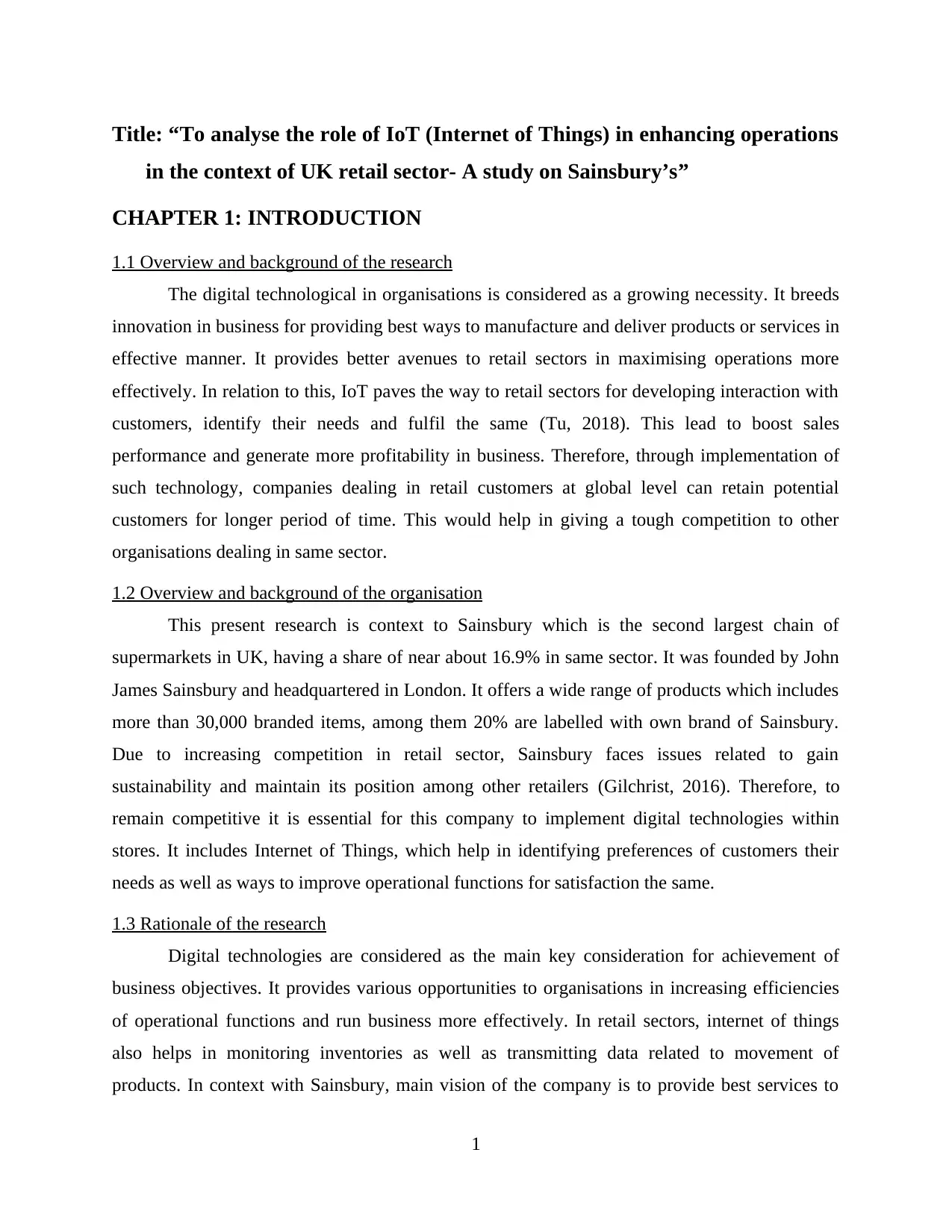
Title: “To analyse the role of IoT (Internet of Things) in enhancing operations
in the context of UK retail sector- A study on Sainsbury’s”
CHAPTER 1: INTRODUCTION
1.1 Overview and background of the research
The digital technological in organisations is considered as a growing necessity. It breeds
innovation in business for providing best ways to manufacture and deliver products or services in
effective manner. It provides better avenues to retail sectors in maximising operations more
effectively. In relation to this, IoT paves the way to retail sectors for developing interaction with
customers, identify their needs and fulfil the same (Tu, 2018). This lead to boost sales
performance and generate more profitability in business. Therefore, through implementation of
such technology, companies dealing in retail customers at global level can retain potential
customers for longer period of time. This would help in giving a tough competition to other
organisations dealing in same sector.
1.2 Overview and background of the organisation
This present research is context to Sainsbury which is the second largest chain of
supermarkets in UK, having a share of near about 16.9% in same sector. It was founded by John
James Sainsbury and headquartered in London. It offers a wide range of products which includes
more than 30,000 branded items, among them 20% are labelled with own brand of Sainsbury.
Due to increasing competition in retail sector, Sainsbury faces issues related to gain
sustainability and maintain its position among other retailers (Gilchrist, 2016). Therefore, to
remain competitive it is essential for this company to implement digital technologies within
stores. It includes Internet of Things, which help in identifying preferences of customers their
needs as well as ways to improve operational functions for satisfaction the same.
1.3 Rationale of the research
Digital technologies are considered as the main key consideration for achievement of
business objectives. It provides various opportunities to organisations in increasing efficiencies
of operational functions and run business more effectively. In retail sectors, internet of things
also helps in monitoring inventories as well as transmitting data related to movement of
products. In context with Sainsbury, main vision of the company is to provide best services to
1
in the context of UK retail sector- A study on Sainsbury’s”
CHAPTER 1: INTRODUCTION
1.1 Overview and background of the research
The digital technological in organisations is considered as a growing necessity. It breeds
innovation in business for providing best ways to manufacture and deliver products or services in
effective manner. It provides better avenues to retail sectors in maximising operations more
effectively. In relation to this, IoT paves the way to retail sectors for developing interaction with
customers, identify their needs and fulfil the same (Tu, 2018). This lead to boost sales
performance and generate more profitability in business. Therefore, through implementation of
such technology, companies dealing in retail customers at global level can retain potential
customers for longer period of time. This would help in giving a tough competition to other
organisations dealing in same sector.
1.2 Overview and background of the organisation
This present research is context to Sainsbury which is the second largest chain of
supermarkets in UK, having a share of near about 16.9% in same sector. It was founded by John
James Sainsbury and headquartered in London. It offers a wide range of products which includes
more than 30,000 branded items, among them 20% are labelled with own brand of Sainsbury.
Due to increasing competition in retail sector, Sainsbury faces issues related to gain
sustainability and maintain its position among other retailers (Gilchrist, 2016). Therefore, to
remain competitive it is essential for this company to implement digital technologies within
stores. It includes Internet of Things, which help in identifying preferences of customers their
needs as well as ways to improve operational functions for satisfaction the same.
1.3 Rationale of the research
Digital technologies are considered as the main key consideration for achievement of
business objectives. It provides various opportunities to organisations in increasing efficiencies
of operational functions and run business more effectively. In retail sectors, internet of things
also helps in monitoring inventories as well as transmitting data related to movement of
products. In context with Sainsbury, main vision of the company is to provide best services to
1
Paraphrase This Document
Need a fresh take? Get an instant paraphrase of this document with our AI Paraphraser
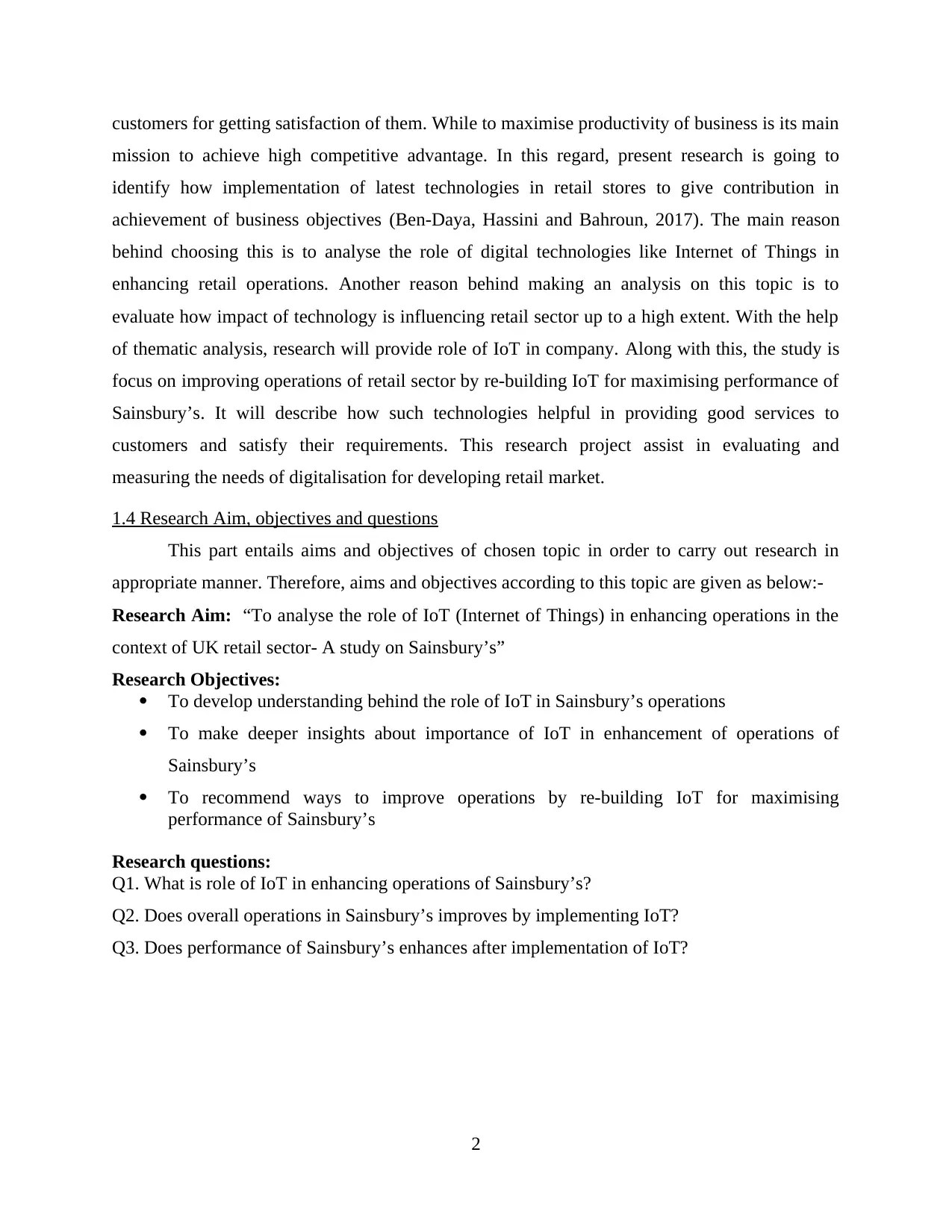
customers for getting satisfaction of them. While to maximise productivity of business is its main
mission to achieve high competitive advantage. In this regard, present research is going to
identify how implementation of latest technologies in retail stores to give contribution in
achievement of business objectives (Ben-Daya, Hassini and Bahroun, 2017). The main reason
behind choosing this is to analyse the role of digital technologies like Internet of Things in
enhancing retail operations. Another reason behind making an analysis on this topic is to
evaluate how impact of technology is influencing retail sector up to a high extent. With the help
of thematic analysis, research will provide role of IoT in company. Along with this, the study is
focus on improving operations of retail sector by re-building IoT for maximising performance of
Sainsbury’s. It will describe how such technologies helpful in providing good services to
customers and satisfy their requirements. This research project assist in evaluating and
measuring the needs of digitalisation for developing retail market.
1.4 Research Aim, objectives and questions
This part entails aims and objectives of chosen topic in order to carry out research in
appropriate manner. Therefore, aims and objectives according to this topic are given as below:-
Research Aim: “To analyse the role of IoT (Internet of Things) in enhancing operations in the
context of UK retail sector- A study on Sainsbury’s”
Research Objectives:
To develop understanding behind the role of IoT in Sainsbury’s operations
To make deeper insights about importance of IoT in enhancement of operations of
Sainsbury’s
To recommend ways to improve operations by re-building IoT for maximising
performance of Sainsbury’s
Research questions:
Q1. What is role of IoT in enhancing operations of Sainsbury’s?
Q2. Does overall operations in Sainsbury’s improves by implementing IoT?
Q3. Does performance of Sainsbury’s enhances after implementation of IoT?
2
mission to achieve high competitive advantage. In this regard, present research is going to
identify how implementation of latest technologies in retail stores to give contribution in
achievement of business objectives (Ben-Daya, Hassini and Bahroun, 2017). The main reason
behind choosing this is to analyse the role of digital technologies like Internet of Things in
enhancing retail operations. Another reason behind making an analysis on this topic is to
evaluate how impact of technology is influencing retail sector up to a high extent. With the help
of thematic analysis, research will provide role of IoT in company. Along with this, the study is
focus on improving operations of retail sector by re-building IoT for maximising performance of
Sainsbury’s. It will describe how such technologies helpful in providing good services to
customers and satisfy their requirements. This research project assist in evaluating and
measuring the needs of digitalisation for developing retail market.
1.4 Research Aim, objectives and questions
This part entails aims and objectives of chosen topic in order to carry out research in
appropriate manner. Therefore, aims and objectives according to this topic are given as below:-
Research Aim: “To analyse the role of IoT (Internet of Things) in enhancing operations in the
context of UK retail sector- A study on Sainsbury’s”
Research Objectives:
To develop understanding behind the role of IoT in Sainsbury’s operations
To make deeper insights about importance of IoT in enhancement of operations of
Sainsbury’s
To recommend ways to improve operations by re-building IoT for maximising
performance of Sainsbury’s
Research questions:
Q1. What is role of IoT in enhancing operations of Sainsbury’s?
Q2. Does overall operations in Sainsbury’s improves by implementing IoT?
Q3. Does performance of Sainsbury’s enhances after implementation of IoT?
2
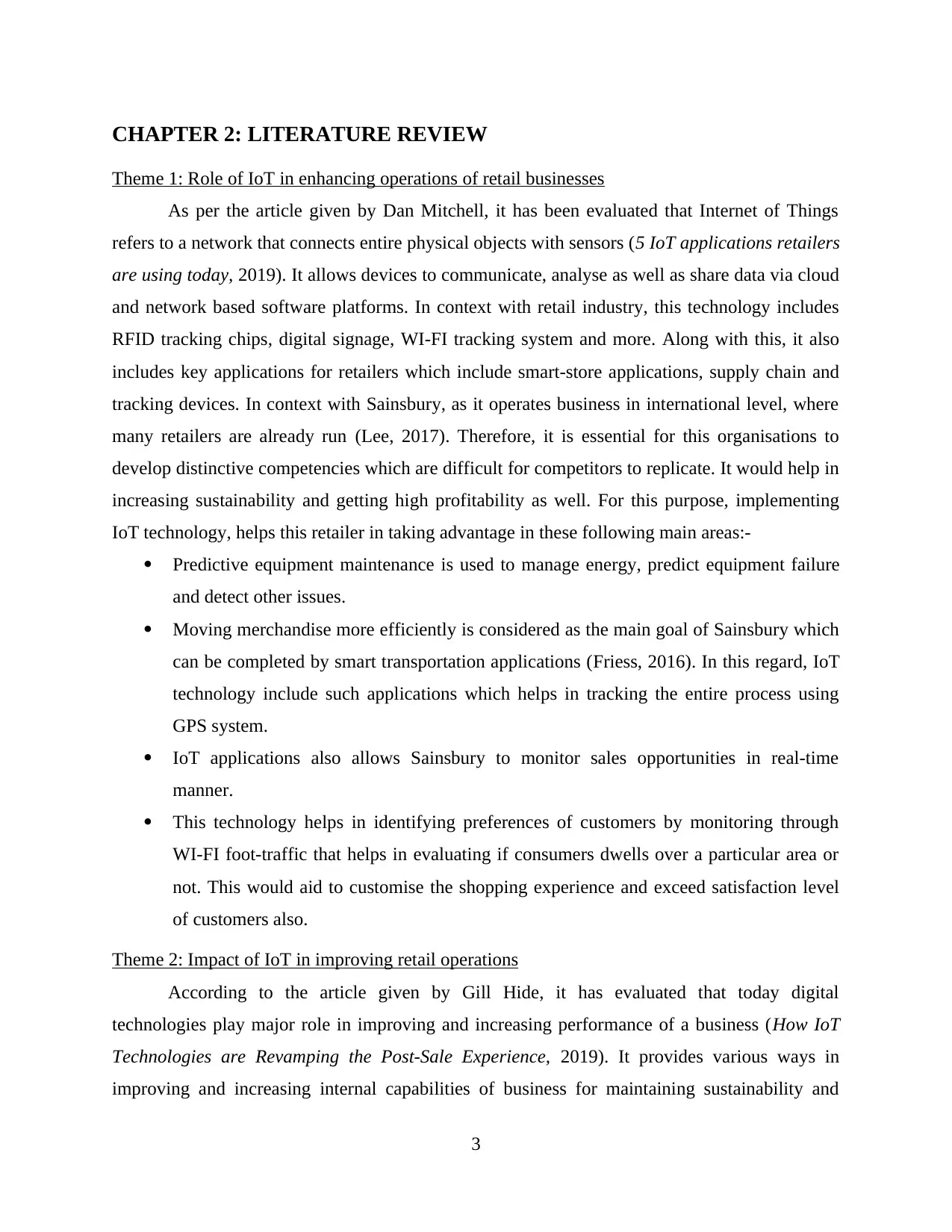
CHAPTER 2: LITERATURE REVIEW
Theme 1: Role of IoT in enhancing operations of retail businesses
As per the article given by Dan Mitchell, it has been evaluated that Internet of Things
refers to a network that connects entire physical objects with sensors (5 IoT applications retailers
are using today, 2019). It allows devices to communicate, analyse as well as share data via cloud
and network based software platforms. In context with retail industry, this technology includes
RFID tracking chips, digital signage, WI-FI tracking system and more. Along with this, it also
includes key applications for retailers which include smart-store applications, supply chain and
tracking devices. In context with Sainsbury, as it operates business in international level, where
many retailers are already run (Lee, 2017). Therefore, it is essential for this organisations to
develop distinctive competencies which are difficult for competitors to replicate. It would help in
increasing sustainability and getting high profitability as well. For this purpose, implementing
IoT technology, helps this retailer in taking advantage in these following main areas:-
Predictive equipment maintenance is used to manage energy, predict equipment failure
and detect other issues.
Moving merchandise more efficiently is considered as the main goal of Sainsbury which
can be completed by smart transportation applications (Friess, 2016). In this regard, IoT
technology include such applications which helps in tracking the entire process using
GPS system.
IoT applications also allows Sainsbury to monitor sales opportunities in real-time
manner.
This technology helps in identifying preferences of customers by monitoring through
WI-FI foot-traffic that helps in evaluating if consumers dwells over a particular area or
not. This would aid to customise the shopping experience and exceed satisfaction level
of customers also.
Theme 2: Impact of IoT in improving retail operations
According to the article given by Gill Hide, it has evaluated that today digital
technologies play major role in improving and increasing performance of a business (How IoT
Technologies are Revamping the Post-Sale Experience, 2019). It provides various ways in
improving and increasing internal capabilities of business for maintaining sustainability and
3
Theme 1: Role of IoT in enhancing operations of retail businesses
As per the article given by Dan Mitchell, it has been evaluated that Internet of Things
refers to a network that connects entire physical objects with sensors (5 IoT applications retailers
are using today, 2019). It allows devices to communicate, analyse as well as share data via cloud
and network based software platforms. In context with retail industry, this technology includes
RFID tracking chips, digital signage, WI-FI tracking system and more. Along with this, it also
includes key applications for retailers which include smart-store applications, supply chain and
tracking devices. In context with Sainsbury, as it operates business in international level, where
many retailers are already run (Lee, 2017). Therefore, it is essential for this organisations to
develop distinctive competencies which are difficult for competitors to replicate. It would help in
increasing sustainability and getting high profitability as well. For this purpose, implementing
IoT technology, helps this retailer in taking advantage in these following main areas:-
Predictive equipment maintenance is used to manage energy, predict equipment failure
and detect other issues.
Moving merchandise more efficiently is considered as the main goal of Sainsbury which
can be completed by smart transportation applications (Friess, 2016). In this regard, IoT
technology include such applications which helps in tracking the entire process using
GPS system.
IoT applications also allows Sainsbury to monitor sales opportunities in real-time
manner.
This technology helps in identifying preferences of customers by monitoring through
WI-FI foot-traffic that helps in evaluating if consumers dwells over a particular area or
not. This would aid to customise the shopping experience and exceed satisfaction level
of customers also.
Theme 2: Impact of IoT in improving retail operations
According to the article given by Gill Hide, it has evaluated that today digital
technologies play major role in improving and increasing performance of a business (How IoT
Technologies are Revamping the Post-Sale Experience, 2019). It provides various ways in
improving and increasing internal capabilities of business for maintaining sustainability and
3
⊘ This is a preview!⊘
Do you want full access?
Subscribe today to unlock all pages.

Trusted by 1+ million students worldwide
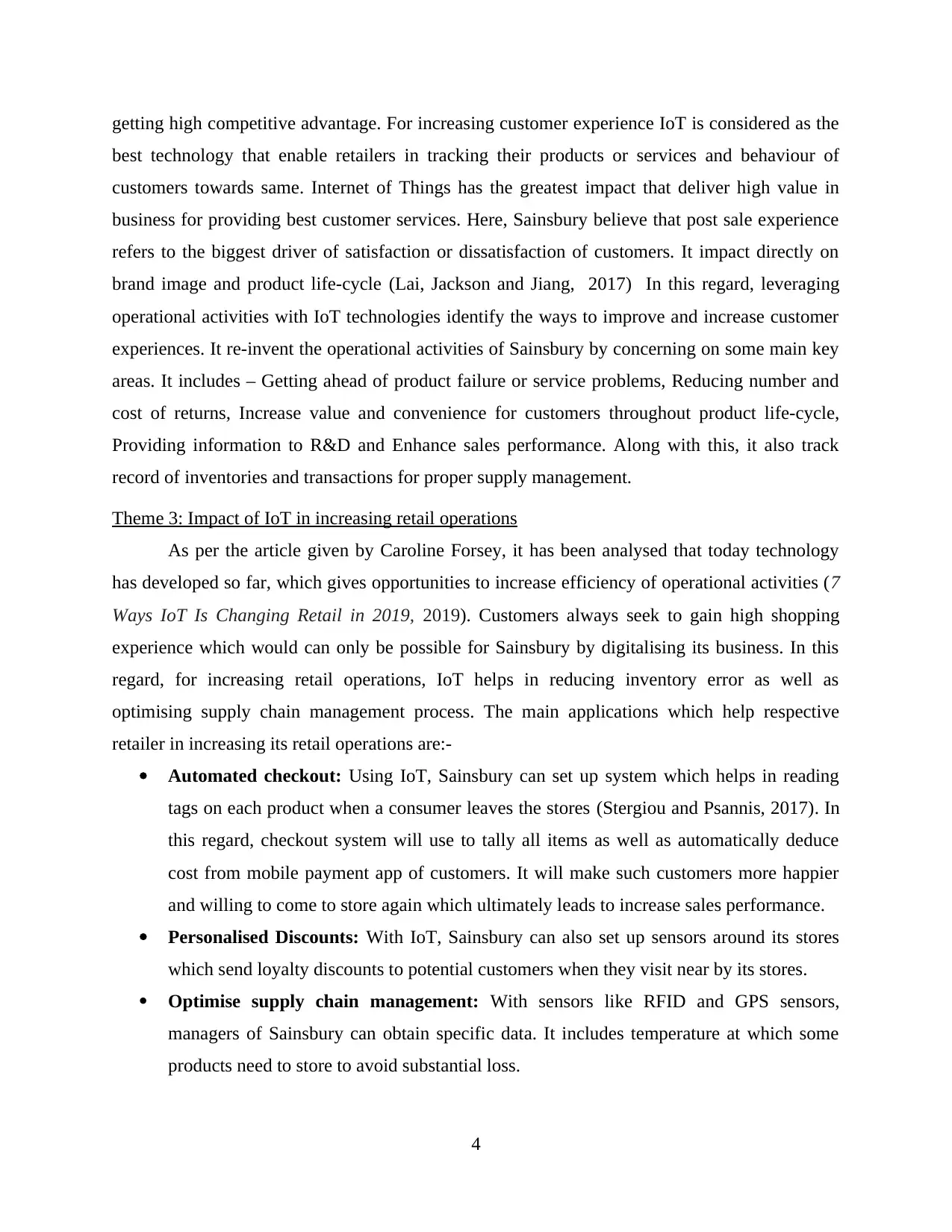
getting high competitive advantage. For increasing customer experience IoT is considered as the
best technology that enable retailers in tracking their products or services and behaviour of
customers towards same. Internet of Things has the greatest impact that deliver high value in
business for providing best customer services. Here, Sainsbury believe that post sale experience
refers to the biggest driver of satisfaction or dissatisfaction of customers. It impact directly on
brand image and product life-cycle (Lai, Jackson and Jiang, 2017) In this regard, leveraging
operational activities with IoT technologies identify the ways to improve and increase customer
experiences. It re-invent the operational activities of Sainsbury by concerning on some main key
areas. It includes – Getting ahead of product failure or service problems, Reducing number and
cost of returns, Increase value and convenience for customers throughout product life-cycle,
Providing information to R&D and Enhance sales performance. Along with this, it also track
record of inventories and transactions for proper supply management.
Theme 3: Impact of IoT in increasing retail operations
As per the article given by Caroline Forsey, it has been analysed that today technology
has developed so far, which gives opportunities to increase efficiency of operational activities (7
Ways IoT Is Changing Retail in 2019, 2019). Customers always seek to gain high shopping
experience which would can only be possible for Sainsbury by digitalising its business. In this
regard, for increasing retail operations, IoT helps in reducing inventory error as well as
optimising supply chain management process. The main applications which help respective
retailer in increasing its retail operations are:-
Automated checkout: Using IoT, Sainsbury can set up system which helps in reading
tags on each product when a consumer leaves the stores (Stergiou and Psannis, 2017). In
this regard, checkout system will use to tally all items as well as automatically deduce
cost from mobile payment app of customers. It will make such customers more happier
and willing to come to store again which ultimately leads to increase sales performance.
Personalised Discounts: With IoT, Sainsbury can also set up sensors around its stores
which send loyalty discounts to potential customers when they visit near by its stores.
Optimise supply chain management: With sensors like RFID and GPS sensors,
managers of Sainsbury can obtain specific data. It includes temperature at which some
products need to store to avoid substantial loss.
4
best technology that enable retailers in tracking their products or services and behaviour of
customers towards same. Internet of Things has the greatest impact that deliver high value in
business for providing best customer services. Here, Sainsbury believe that post sale experience
refers to the biggest driver of satisfaction or dissatisfaction of customers. It impact directly on
brand image and product life-cycle (Lai, Jackson and Jiang, 2017) In this regard, leveraging
operational activities with IoT technologies identify the ways to improve and increase customer
experiences. It re-invent the operational activities of Sainsbury by concerning on some main key
areas. It includes – Getting ahead of product failure or service problems, Reducing number and
cost of returns, Increase value and convenience for customers throughout product life-cycle,
Providing information to R&D and Enhance sales performance. Along with this, it also track
record of inventories and transactions for proper supply management.
Theme 3: Impact of IoT in increasing retail operations
As per the article given by Caroline Forsey, it has been analysed that today technology
has developed so far, which gives opportunities to increase efficiency of operational activities (7
Ways IoT Is Changing Retail in 2019, 2019). Customers always seek to gain high shopping
experience which would can only be possible for Sainsbury by digitalising its business. In this
regard, for increasing retail operations, IoT helps in reducing inventory error as well as
optimising supply chain management process. The main applications which help respective
retailer in increasing its retail operations are:-
Automated checkout: Using IoT, Sainsbury can set up system which helps in reading
tags on each product when a consumer leaves the stores (Stergiou and Psannis, 2017). In
this regard, checkout system will use to tally all items as well as automatically deduce
cost from mobile payment app of customers. It will make such customers more happier
and willing to come to store again which ultimately leads to increase sales performance.
Personalised Discounts: With IoT, Sainsbury can also set up sensors around its stores
which send loyalty discounts to potential customers when they visit near by its stores.
Optimise supply chain management: With sensors like RFID and GPS sensors,
managers of Sainsbury can obtain specific data. It includes temperature at which some
products need to store to avoid substantial loss.
4
Paraphrase This Document
Need a fresh take? Get an instant paraphrase of this document with our AI Paraphraser
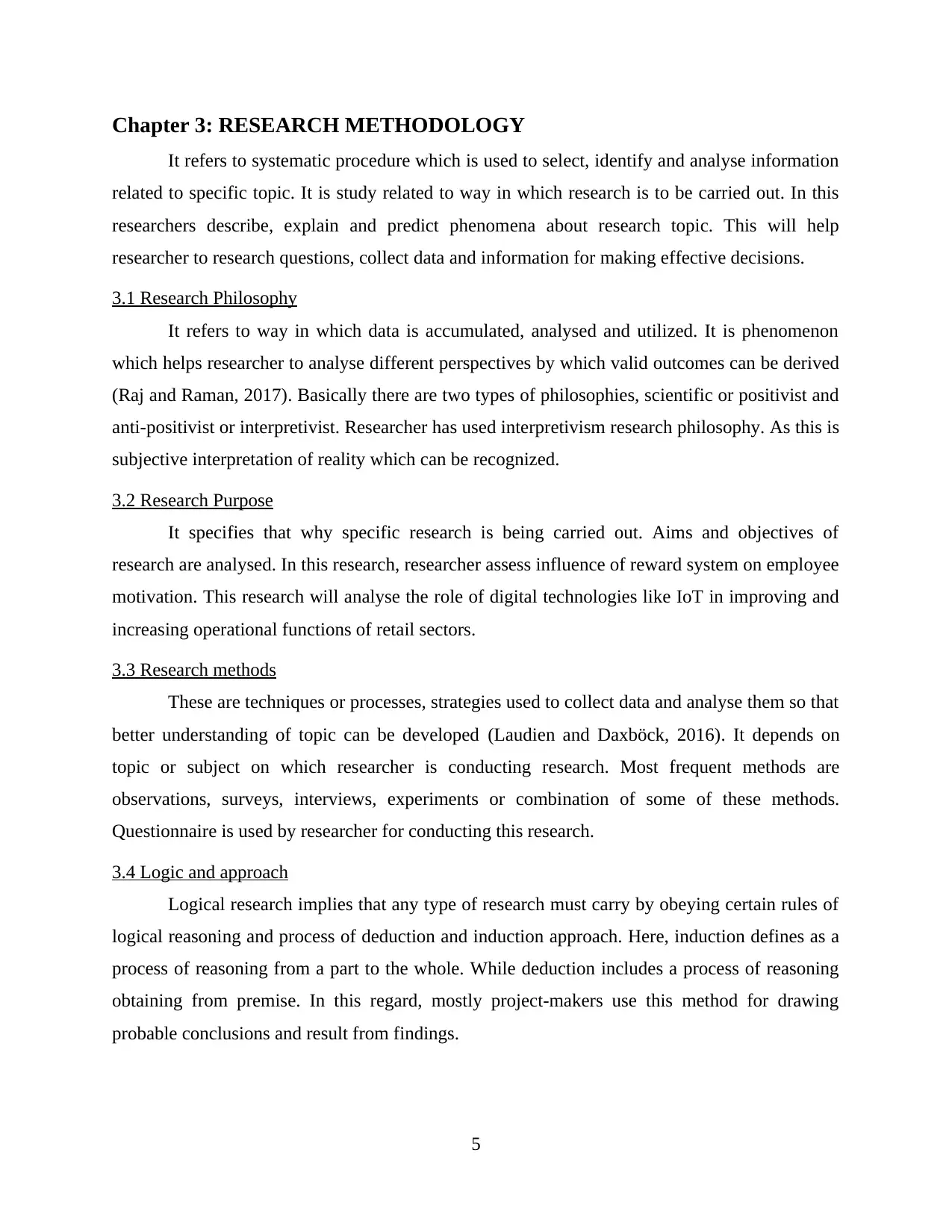
Chapter 3: RESEARCH METHODOLOGY
It refers to systematic procedure which is used to select, identify and analyse information
related to specific topic. It is study related to way in which research is to be carried out. In this
researchers describe, explain and predict phenomena about research topic. This will help
researcher to research questions, collect data and information for making effective decisions.
3.1 Research Philosophy
It refers to way in which data is accumulated, analysed and utilized. It is phenomenon
which helps researcher to analyse different perspectives by which valid outcomes can be derived
(Raj and Raman, 2017). Basically there are two types of philosophies, scientific or positivist and
anti-positivist or interpretivist. Researcher has used interpretivism research philosophy. As this is
subjective interpretation of reality which can be recognized.
3.2 Research Purpose
It specifies that why specific research is being carried out. Aims and objectives of
research are analysed. In this research, researcher assess influence of reward system on employee
motivation. This research will analyse the role of digital technologies like IoT in improving and
increasing operational functions of retail sectors.
3.3 Research methods
These are techniques or processes, strategies used to collect data and analyse them so that
better understanding of topic can be developed (Laudien and Daxböck, 2016). It depends on
topic or subject on which researcher is conducting research. Most frequent methods are
observations, surveys, interviews, experiments or combination of some of these methods.
Questionnaire is used by researcher for conducting this research.
3.4 Logic and approach
Logical research implies that any type of research must carry by obeying certain rules of
logical reasoning and process of deduction and induction approach. Here, induction defines as a
process of reasoning from a part to the whole. While deduction includes a process of reasoning
obtaining from premise. In this regard, mostly project-makers use this method for drawing
probable conclusions and result from findings.
5
It refers to systematic procedure which is used to select, identify and analyse information
related to specific topic. It is study related to way in which research is to be carried out. In this
researchers describe, explain and predict phenomena about research topic. This will help
researcher to research questions, collect data and information for making effective decisions.
3.1 Research Philosophy
It refers to way in which data is accumulated, analysed and utilized. It is phenomenon
which helps researcher to analyse different perspectives by which valid outcomes can be derived
(Raj and Raman, 2017). Basically there are two types of philosophies, scientific or positivist and
anti-positivist or interpretivist. Researcher has used interpretivism research philosophy. As this is
subjective interpretation of reality which can be recognized.
3.2 Research Purpose
It specifies that why specific research is being carried out. Aims and objectives of
research are analysed. In this research, researcher assess influence of reward system on employee
motivation. This research will analyse the role of digital technologies like IoT in improving and
increasing operational functions of retail sectors.
3.3 Research methods
These are techniques or processes, strategies used to collect data and analyse them so that
better understanding of topic can be developed (Laudien and Daxböck, 2016). It depends on
topic or subject on which researcher is conducting research. Most frequent methods are
observations, surveys, interviews, experiments or combination of some of these methods.
Questionnaire is used by researcher for conducting this research.
3.4 Logic and approach
Logical research implies that any type of research must carry by obeying certain rules of
logical reasoning and process of deduction and induction approach. Here, induction defines as a
process of reasoning from a part to the whole. While deduction includes a process of reasoning
obtaining from premise. In this regard, mostly project-makers use this method for drawing
probable conclusions and result from findings.
5
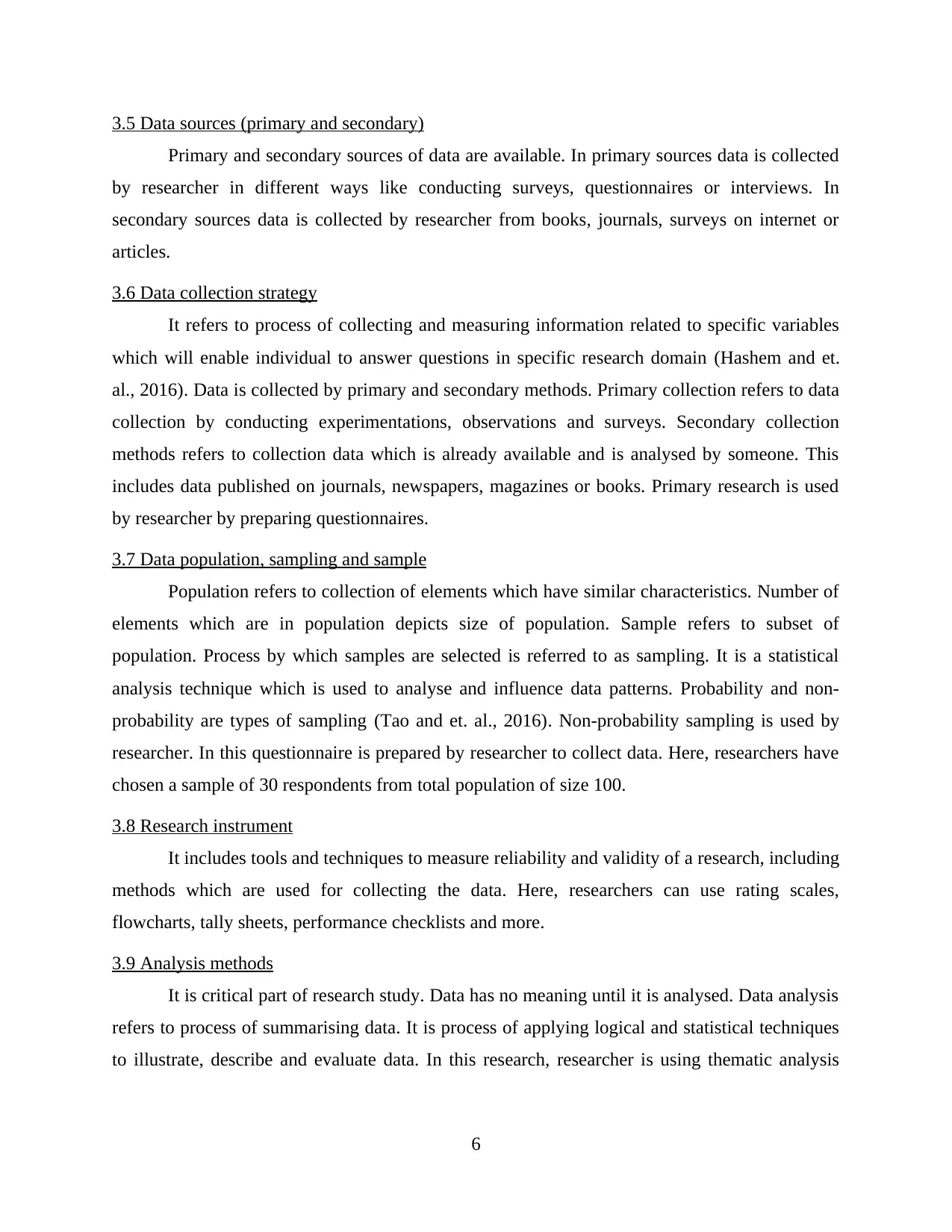
3.5 Data sources (primary and secondary)
Primary and secondary sources of data are available. In primary sources data is collected
by researcher in different ways like conducting surveys, questionnaires or interviews. In
secondary sources data is collected by researcher from books, journals, surveys on internet or
articles.
3.6 Data collection strategy
It refers to process of collecting and measuring information related to specific variables
which will enable individual to answer questions in specific research domain (Hashem and et.
al., 2016). Data is collected by primary and secondary methods. Primary collection refers to data
collection by conducting experimentations, observations and surveys. Secondary collection
methods refers to collection data which is already available and is analysed by someone. This
includes data published on journals, newspapers, magazines or books. Primary research is used
by researcher by preparing questionnaires.
3.7 Data population, sampling and sample
Population refers to collection of elements which have similar characteristics. Number of
elements which are in population depicts size of population. Sample refers to subset of
population. Process by which samples are selected is referred to as sampling. It is a statistical
analysis technique which is used to analyse and influence data patterns. Probability and non-
probability are types of sampling (Tao and et. al., 2016). Non-probability sampling is used by
researcher. In this questionnaire is prepared by researcher to collect data. Here, researchers have
chosen a sample of 30 respondents from total population of size 100.
3.8 Research instrument
It includes tools and techniques to measure reliability and validity of a research, including
methods which are used for collecting the data. Here, researchers can use rating scales,
flowcharts, tally sheets, performance checklists and more.
3.9 Analysis methods
It is critical part of research study. Data has no meaning until it is analysed. Data analysis
refers to process of summarising data. It is process of applying logical and statistical techniques
to illustrate, describe and evaluate data. In this research, researcher is using thematic analysis
6
Primary and secondary sources of data are available. In primary sources data is collected
by researcher in different ways like conducting surveys, questionnaires or interviews. In
secondary sources data is collected by researcher from books, journals, surveys on internet or
articles.
3.6 Data collection strategy
It refers to process of collecting and measuring information related to specific variables
which will enable individual to answer questions in specific research domain (Hashem and et.
al., 2016). Data is collected by primary and secondary methods. Primary collection refers to data
collection by conducting experimentations, observations and surveys. Secondary collection
methods refers to collection data which is already available and is analysed by someone. This
includes data published on journals, newspapers, magazines or books. Primary research is used
by researcher by preparing questionnaires.
3.7 Data population, sampling and sample
Population refers to collection of elements which have similar characteristics. Number of
elements which are in population depicts size of population. Sample refers to subset of
population. Process by which samples are selected is referred to as sampling. It is a statistical
analysis technique which is used to analyse and influence data patterns. Probability and non-
probability are types of sampling (Tao and et. al., 2016). Non-probability sampling is used by
researcher. In this questionnaire is prepared by researcher to collect data. Here, researchers have
chosen a sample of 30 respondents from total population of size 100.
3.8 Research instrument
It includes tools and techniques to measure reliability and validity of a research, including
methods which are used for collecting the data. Here, researchers can use rating scales,
flowcharts, tally sheets, performance checklists and more.
3.9 Analysis methods
It is critical part of research study. Data has no meaning until it is analysed. Data analysis
refers to process of summarising data. It is process of applying logical and statistical techniques
to illustrate, describe and evaluate data. In this research, researcher is using thematic analysis
6
⊘ This is a preview!⊘
Do you want full access?
Subscribe today to unlock all pages.

Trusted by 1+ million students worldwide
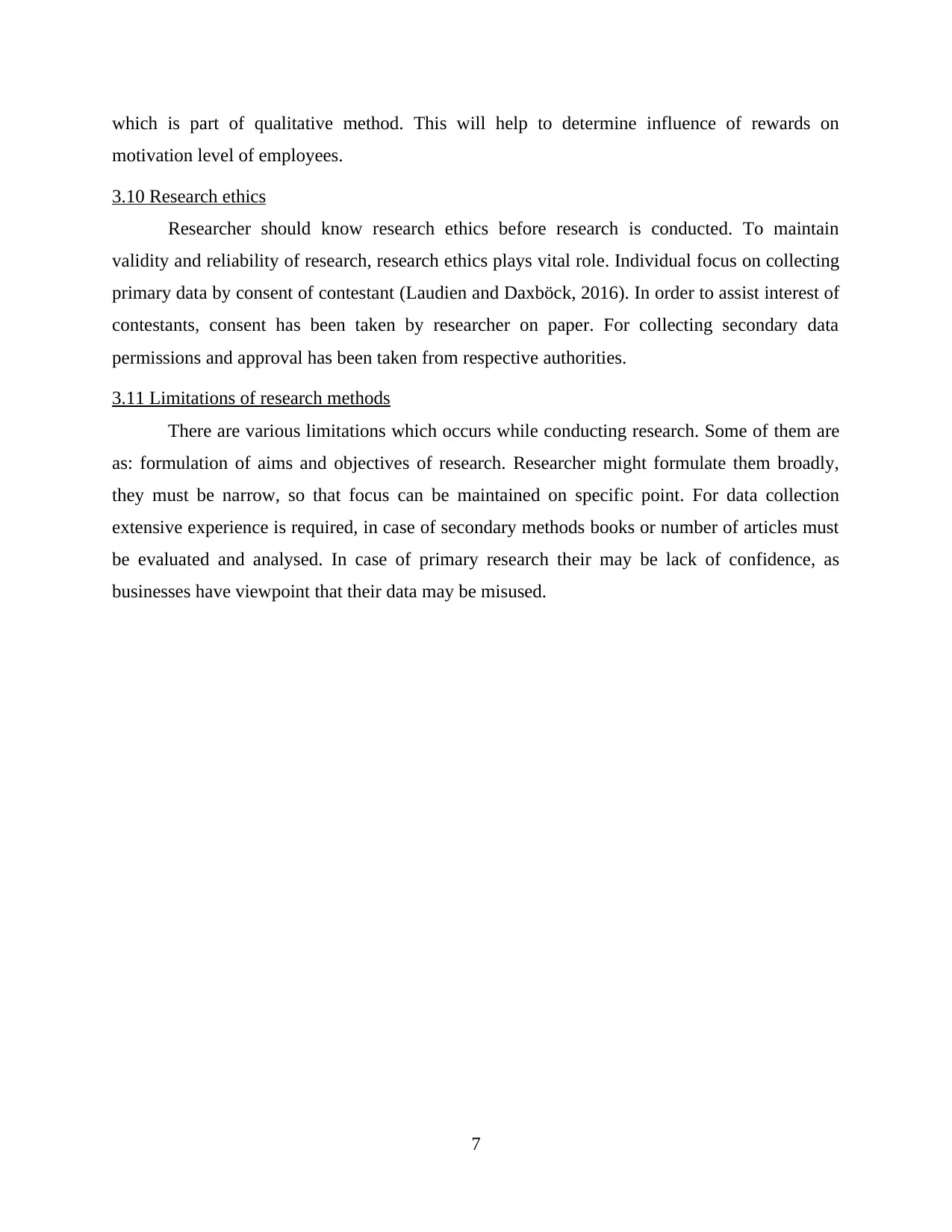
which is part of qualitative method. This will help to determine influence of rewards on
motivation level of employees.
3.10 Research ethics
Researcher should know research ethics before research is conducted. To maintain
validity and reliability of research, research ethics plays vital role. Individual focus on collecting
primary data by consent of contestant (Laudien and Daxböck, 2016). In order to assist interest of
contestants, consent has been taken by researcher on paper. For collecting secondary data
permissions and approval has been taken from respective authorities.
3.11 Limitations of research methods
There are various limitations which occurs while conducting research. Some of them are
as: formulation of aims and objectives of research. Researcher might formulate them broadly,
they must be narrow, so that focus can be maintained on specific point. For data collection
extensive experience is required, in case of secondary methods books or number of articles must
be evaluated and analysed. In case of primary research their may be lack of confidence, as
businesses have viewpoint that their data may be misused.
7
motivation level of employees.
3.10 Research ethics
Researcher should know research ethics before research is conducted. To maintain
validity and reliability of research, research ethics plays vital role. Individual focus on collecting
primary data by consent of contestant (Laudien and Daxböck, 2016). In order to assist interest of
contestants, consent has been taken by researcher on paper. For collecting secondary data
permissions and approval has been taken from respective authorities.
3.11 Limitations of research methods
There are various limitations which occurs while conducting research. Some of them are
as: formulation of aims and objectives of research. Researcher might formulate them broadly,
they must be narrow, so that focus can be maintained on specific point. For data collection
extensive experience is required, in case of secondary methods books or number of articles must
be evaluated and analysed. In case of primary research their may be lack of confidence, as
businesses have viewpoint that their data may be misused.
7
Paraphrase This Document
Need a fresh take? Get an instant paraphrase of this document with our AI Paraphraser
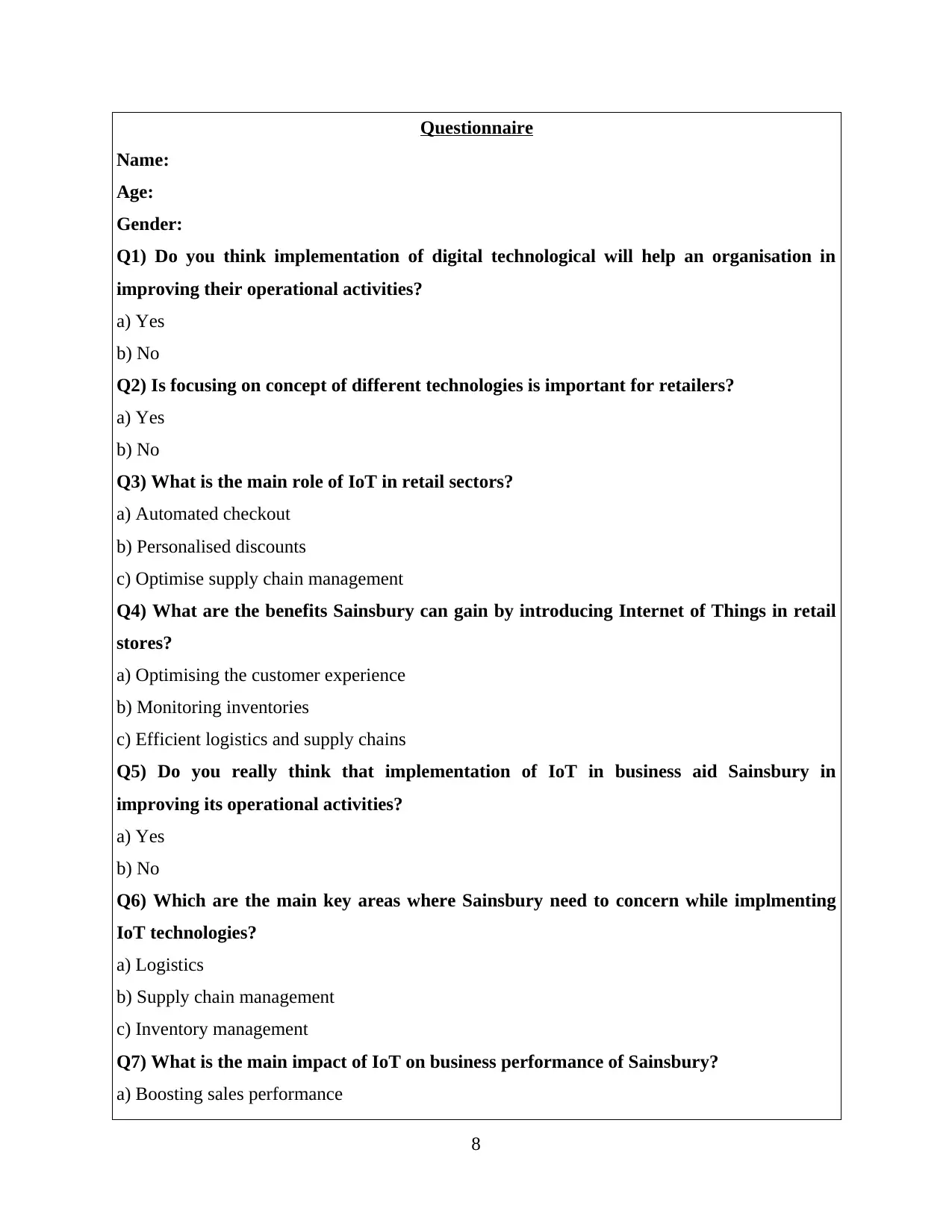
Questionnaire
Name:
Age:
Gender:
Q1) Do you think implementation of digital technological will help an organisation in
improving their operational activities?
a) Yes
b) No
Q2) Is focusing on concept of different technologies is important for retailers?
a) Yes
b) No
Q3) What is the main role of IoT in retail sectors?
a) Automated checkout
b) Personalised discounts
c) Optimise supply chain management
Q4) What are the benefits Sainsbury can gain by introducing Internet of Things in retail
stores?
a) Optimising the customer experience
b) Monitoring inventories
c) Efficient logistics and supply chains
Q5) Do you really think that implementation of IoT in business aid Sainsbury in
improving its operational activities?
a) Yes
b) No
Q6) Which are the main key areas where Sainsbury need to concern while implmenting
IoT technologies?
a) Logistics
b) Supply chain management
c) Inventory management
Q7) What is the main impact of IoT on business performance of Sainsbury?
a) Boosting sales performance
8
Name:
Age:
Gender:
Q1) Do you think implementation of digital technological will help an organisation in
improving their operational activities?
a) Yes
b) No
Q2) Is focusing on concept of different technologies is important for retailers?
a) Yes
b) No
Q3) What is the main role of IoT in retail sectors?
a) Automated checkout
b) Personalised discounts
c) Optimise supply chain management
Q4) What are the benefits Sainsbury can gain by introducing Internet of Things in retail
stores?
a) Optimising the customer experience
b) Monitoring inventories
c) Efficient logistics and supply chains
Q5) Do you really think that implementation of IoT in business aid Sainsbury in
improving its operational activities?
a) Yes
b) No
Q6) Which are the main key areas where Sainsbury need to concern while implmenting
IoT technologies?
a) Logistics
b) Supply chain management
c) Inventory management
Q7) What is the main impact of IoT on business performance of Sainsbury?
a) Boosting sales performance
8
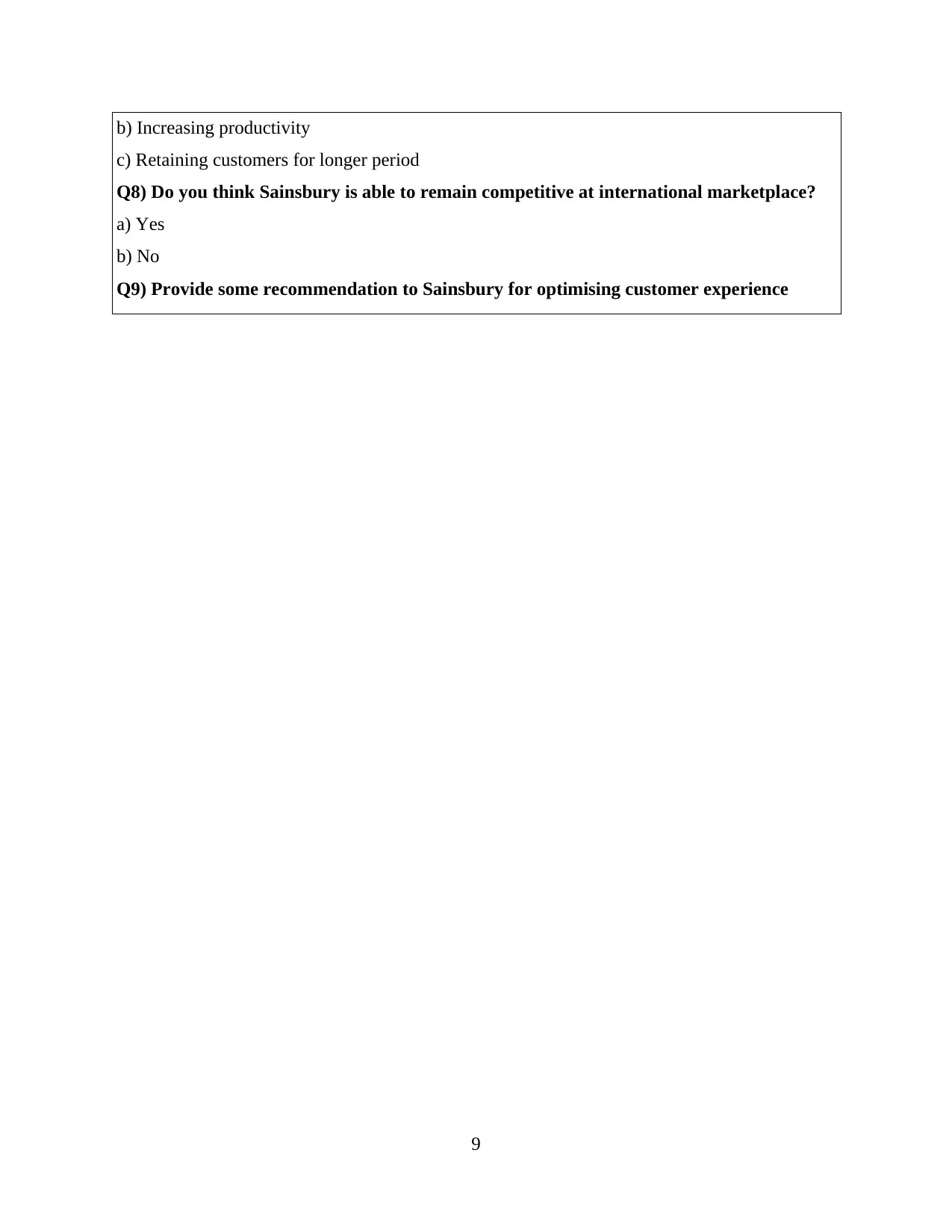
b) Increasing productivity
c) Retaining customers for longer period
Q8) Do you think Sainsbury is able to remain competitive at international marketplace?
a) Yes
b) No
Q9) Provide some recommendation to Sainsbury for optimising customer experience
9
c) Retaining customers for longer period
Q8) Do you think Sainsbury is able to remain competitive at international marketplace?
a) Yes
b) No
Q9) Provide some recommendation to Sainsbury for optimising customer experience
9
⊘ This is a preview!⊘
Do you want full access?
Subscribe today to unlock all pages.

Trusted by 1+ million students worldwide
1 out of 25
Related Documents
Your All-in-One AI-Powered Toolkit for Academic Success.
+13062052269
info@desklib.com
Available 24*7 on WhatsApp / Email
![[object Object]](/_next/static/media/star-bottom.7253800d.svg)
Unlock your academic potential
Copyright © 2020–2025 A2Z Services. All Rights Reserved. Developed and managed by ZUCOL.





